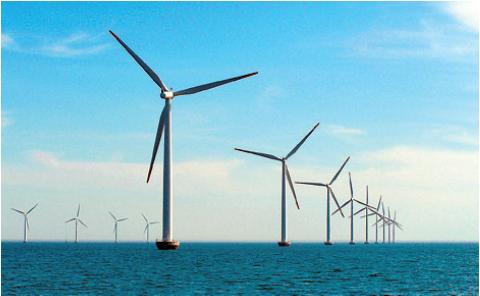 After nine years of debate, approval of the Cape Wind project boiled down to the decision of one man, Secretary of the Interior Ken Salazar. On April 24th, he decided in favor.
After nine years of debate, approval of the Cape Wind project boiled down to the decision of one man, Secretary of the Interior Ken Salazar. On April 24th, he decided in favor.
Senator Ted Kennedy was vigorously opposed to installing the 130 3.6-MW turbines (468 MW total, nameplate) in shallow water in Nantucket Sound so near to the family compound at Hyannis Port, Massachusetts. The hub height will be 87 meters (285 feet), and the blade diameter will be 111 m (364 feet).
The website Capewind.org says, “130 wind turbines will gracefully harness the wind to produce up to 420 megawatts of clean, renewable energy” in “Project at a glance” and says, “Cape Wind will be rated to produce up to 468 megawatts of wind power as each wind turbine will produce up to 3.6 megawatts. Maximum expected production will be 454 megawatts,” in “Frequently Asked Questions.”
According to developers, the Cape Wind project will produce a year-round average of 170 MW. In other words, they expect an annual capacity factor of 36%, based on the nameplate rating of 468 MW.
The turbines will be spread out over 62 square kilometers (24 square miles). If the facility actually produces 170 MW on average, it will produce 27.4 kW per hectare, (11 kW per acre) which is approximately double the usual 12.5 kW per hectare (5 kW per acre) produced by land-based wind “farms” in excellent locations.
The job of a wind turbine is to extract energy from the wind. Perforce, the wind behind the turbine is slower than in front, and spread out as well. There is also considerable turbulence. About 10 diameters behind the wind turbine, the air is back up to normal speed and the turbulence has dissipated.
If the wind comes from random directions, then an engineering rule-of-thumb says that wind turbines should be spaced about 10 diameters apart in all directions. However, if the wind always comes from one direction, then the turbines can be about 3 diameters apart in the direction perpendicular to the wind velocity. Accordingly, the power density (kW per unit area) can in principle be better with prevailing winds from one direction. Presumably, the Cape Wind facility is such a site, because the promoters expect about twice the power density obtained in most wind “farms” in good sites. Indeed, “Within a row, the wind turbines will be .34 nautical miles apart (about 6 football fields), the rows will be .54 nautical miles apart (about 9 football fields).” [1] Let us translate. One nautical mile is 1,852 meters. Within a row, the turbines will be 5.67 diameters apart, and the rows will be 9 diameters apart.
The average power output, 170 MW, is about 75% of the average power demand for Cape Cod, Martha’s Vineyard, and Nantucket island combined. At times, however, the project will produce 454 MW, which is over twice the average demand. Depending upon the timing, the high power could well come when the demand is lowest, so that the wind machines might be producing (say) 4 or 5 times the demand at the moment. Such numbers make it clear that the Cape Wind project cannot be the sole—or even major—supplier of electricity to Cape Cod, Martha’s Vineyard and Nantucket Island. The wind machines will feed electricity into a grid where the wind power is probably no more than 10% of the grid power.
In any case, the highly variable output cannot and will not be synchronized to the highly variable demand, so conventional power sources will have to stabilize the grid.
Power will have to be gathered from 130 wind turbines spread out over 62 square km (24 square miles) and delivered to the grid at Barnstable, MA [1] with two underwater 115-kV cables buried about 2 meters deep in the sand. The cables have no other purpose than to carry power from the Cape Wind project to Cape Cod, so they will have exactly the same capacity factor as the wind turbines, namely about 36%. Obviously, they’re throwing a lot of money at something that will effectively be idle for 2/3 of the time. Oh, and a mere 765 of these wind turbine spread out over 141 square miles would generate as much energy every year as a single nuke.
Ted Kennedy and others opposed the Cape Wind project on aesthetic grounds. Some Indian tribes have opposed it on grounds that the area might contain ancient artifacts submerged by rising seas for the last 15,000 years or so. These are NIMBY (not-in-myback- yard) arguments that fail to discuss the broader problems with wind: highly variable (hence very unreliable) power, and high cost.
Cost? What cost? Mr. Salazar is mum on the subject. We’ll just pick up the tab on April 15th. Shhhh. 800-959-3421 [1]
http://www.capewind.org/
